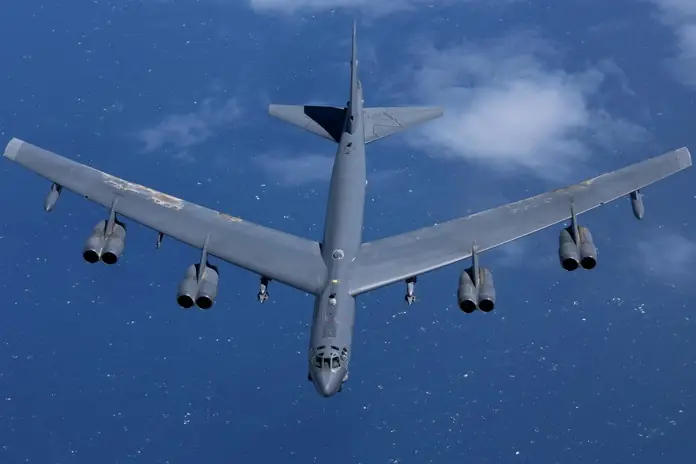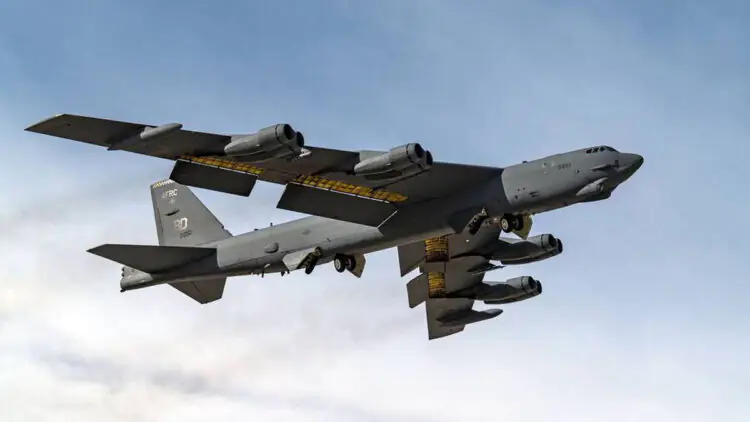On July 21, 2024, two B-52H Stratofortress aircraft from the U.S. Air Force’s 2nd Bomb Wing, based at Barksdale Air Force Base in Louisiana, landed at Mihail Kogălniceanu Air Base in Romania as part of Bomber Task Force 24-4. The deployment included the presence of several KC-135 tanker aircraft from the 100th Air Refueling Wing at RAF Mildenhall. Over the Gulf of Finland, the B-52s were escorted by Finnish Air Force F/A-18C Hornets and German Air Force Eurofighter jets.

While flying over the Barents Sea, the B-52s, operating in international airspace in accordance with international law, were intercepted by two Russian aircraft at around 8 a.m. Central European Time. Despite the interception, the B-52s maintained their course and continued their mission as planned, including integration exercises with NATO fighter jets, before landing at Mihail Kogălniceanu Air Base.
Three USAF tankers returning from mission over Finland. Rumored to refuel B-52s from Barksdale. Report from Russian MOD that it detected two B-52 bombers over the Barents Sea.
If so, first B-52 mission over Finland? No confirmation yet.
h/t @SirListenalot @johnspectator pic.twitter.com/eIL20DCroZ
– Hans Kristensen (@nukestrat) July 21, 2024
This is a translation of the statement released by the Russian Ministry of Defense:
“To identify the air target and prevent a violation of the state border of the Russian Federation, MiG-29 and MiG-31 fighters from the air defense forces on duty were scrambled. The crews of the Russian fighters identified the air target as a pair of USAF B-52H strategic bombers. Upon the approach of the Russian fighters, the American strategic bombers turned away from the state border of the Russian Federation. The Russian aircraft safely returned to their home airfields, and no violation of the state border of the Russian Federation occurred.”

As part of standard deployment, while in Europe, the strategic aircraft will operate as an expeditionary bomber squadron, participating in joint operations with NATO member countries and other international partners to enhance capabilities and strengthen security commitments within the jurisdiction of the U.S. European Command.
.@FinnishAirForce flew a training mission with two 🇺🇸 B-52 bombers today.
🇫🇮 F/A-18 Hornet multirole fighters flew with the 🇺🇸bombers from Lapland to Gulf of Finland where the bombers continued their mission with 🇩🇪 Eurofighters involved in Nato’s BAP mission. #StrongerTogether pic.twitter.com/uIvAKYTHZn– Puolustusvoimat (@Puolustusvoimat) July 21, 2024
This deployment marks the first time American strategic bombers have been deployed from Romanian territory.

General James Hecker, the commander of USAFE-AFAFRICA in Africa, emphasized the importance of being able to provide a wide range of capabilities globally. He noted that the missions of the Bomber Task Force offer valuable opportunities to refine tactics, techniques, and procedures for rapid combat deployment. Hecker highlighted that these joint efforts with Alliance members enable the U.S. Armed Forces to effectively counter current and future threats.

According to a U.S. Air Force representative, the regular deployment of American strategic bombers underscores the United States’ commitment to NATO members and partners. These missions enhance the dynamic employment of forces in the European theater, providing strategic assurance to Alliance members while deterring potential adversaries with operational unpredictability.
Source: theaviationist









